Two Castles Way
Two Castles Way is 24 miles in length - it passes through moorland and wooded river valleys. The name derives from the castle at Okehampton where the trail starts and Launceston where it finishes. Walking is not too strenuous although there are a couple of hill climbs. Two Castles Way is mostly waymarked.
There is a regular bus service at both ends of the walk and plenty of trains to Okehampton from Exeter and vice versa of course.
This walk is both a historical journey as well as a beautiful scenic route through wooded valleys and open moorland.
The castles are medieval.

Okehampton Castle
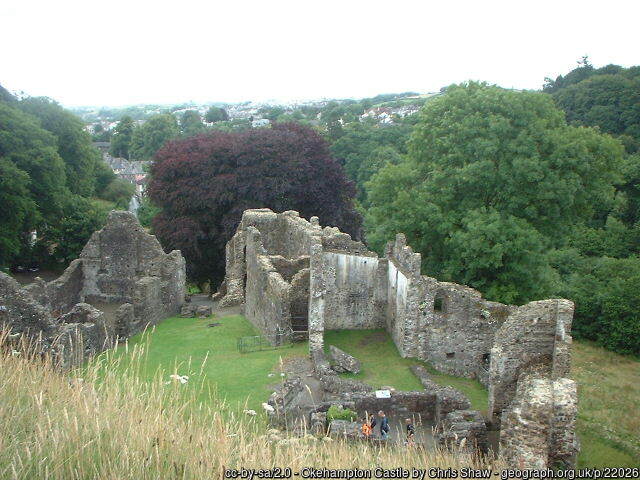
Okehampton Castle
Photograph © Chris Shaw
Said to be haunted Okehampton Castle sits on a hill
above the River Okement. It is the remains of a Norman structure of
motte and bailey construction with a stone keep. Hugh Courtenay, Earl of
Devon, transformed this fortress into a lavish residence, but by 1539
it had declined into a ruin, Makes a great spot for a picnic. English
Heritage run the site.
Current opening times can be found on their site Okehampton Castle

Launceston Castle
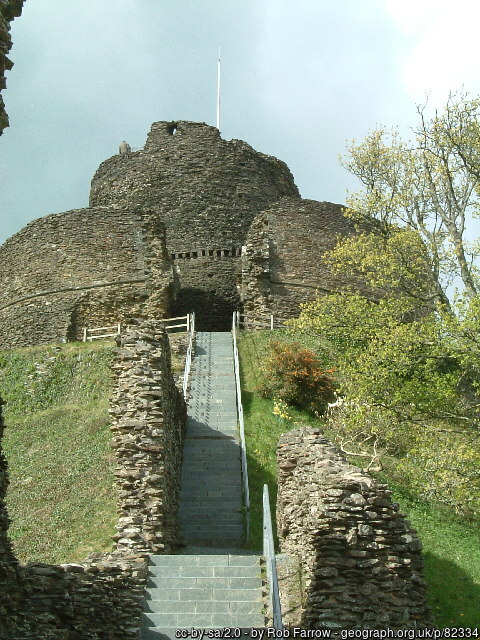
Launceston Castle
Photograph© Rob Farrow
An amazing site is Launceston Castle set high above the surrounding countryside on a steep natural mound, over the border in Cornwall. This castle is different to Okehampton although also of Norman origin. It is an incredible 13th century round tower inside another earlier circular keep. This one was built by Richard, Earl of Cornwall. Originally its name was Dunheved.
The view from the top of the tower is spectacular but must be reached by a dark internal staircase.
Launceston Castle was the prison of George Fox, who founded the Quaker Movement.
This castle too is run by the English Heritage organisation opening times and other information can be found on their site.

The Trail
Two Castles Way is a very pleasant 24 miles walk set up as four stages so one can either walk each stage as a day out or perhaps do them all one after the other as a short break, staying along the way.
There is public transport at each end of each stage so one does not even need the car! Consult Traveline for times of buses before you leave.
Put on your hiking boots, hoist the backpack and enjoy.

Okehampton
Before you leave spend a little time in Okehampton. It is certainly the centre of activity for the region. It is a nice little town in its own right, a gateway to Dartmoor with its many attractive little places like Lydford, Ivybridge and Belstone and it is the start of many footpaths and cycleways through the region.

Stage One
Okehampton to Bridestowe
Seven miles of lovely countryside over fields and down pretty tracks although the last bit into Bridestowe is road. There is one steep hill. The tracks can get muddy and a bit messy in wet weather, but few tracks do not!! Part of the track follows the East Okement River.
Two Castles Way actually starts off as the West Devon Way as it leaves Okehampton and stays that way until the West Devon Way leaves the Two Castles Way just before Bridestowe.
If you have had enough because of that steep hill, there is a bus stop at Stourton.

Bridestowe
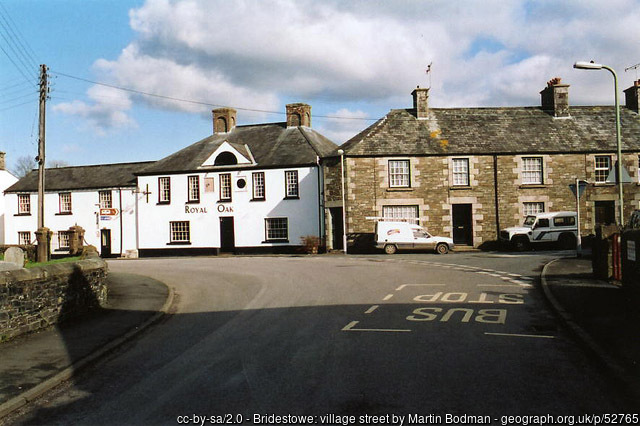
Bridestowe
Photograph © Martin Bodman
An active village of stone and slate that dates back to the 1640's, but there is certainly evidence that there was habitation in the Bronze Age onwards and with early Christianity - "Stow" means ancient holy place. Its lovely church is dedicated to St Bridget.
There is a connection with WWII. the old village hall was a nissan hut where General Eisenhower signed some papers.There is a fantastic new village hall now.

Stage Two
Bridestowe to Lewdown
Once again seven miles of delightful countryside, this time gentle rolling hills, mostly fairly gradual, but again the tracks can be uneven and sometimes messy and muddy.
As you come down steep Galford Down there are views to two moors, Bodmin and Dartmoor. Worth the walk in itself.
There is a hill fort on the route of Two Castles Way where there is said to have been a bloody battle between the Celts and the Saxons.
As you walk down Galford imagine yourself back to the 800's. Imagine the Saxons and the Celts as they fought with ferocity for supremacy. Who actually won that final battle is not really known for certain.
The border of Devon and Cornwall was a real battleground for the Celts and the Saxons. The actual result of that final battle on Galford Down was that the Celts held on to Cornwall and the Saxons of Wessex eventually had to be satisfied with the lands they held east of the border. The River Tamar became the frontier between the two peoples and the border between Devon and Cornwall.
A Cornishman on going into Devon says he is going into England - even now.
Two Castles Way passes Lewtrenchard Manor and Lewtrenchard Church. The Manor is now a fantastic hotel.

"Onward Christian Soldiers"
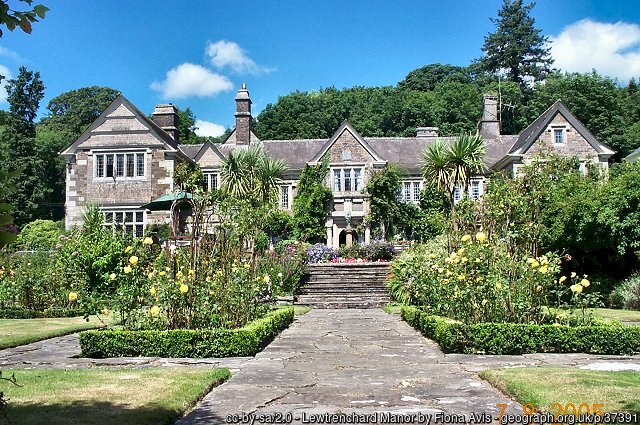
Lewtrenchard Manor
Photoraph © Fiona Avis
The trail runs through open moorland and is a great place for a good singsong. The rousing hymn “Onward Christian Solders” was composed by Sabine Baring-Gould at his home at Lewtrenchard Manor on the route of the Two Castles Way. The music was by Arthur Sullivan.
Sabine Baring-Gould was also a collector of folk songs including the old favourite “Widdicombe Fair” with Uncle Tom Cobley and all. Widdicombe Fair still exists to this day.
Lewtrenchard Manor is now a stunning hotel set in a wooded valley beneath the wild moorland. The desk where Sabine Baring-Gould wrote is still in the library there.

Stage Three
Lewdown to Lifton
via Stowford
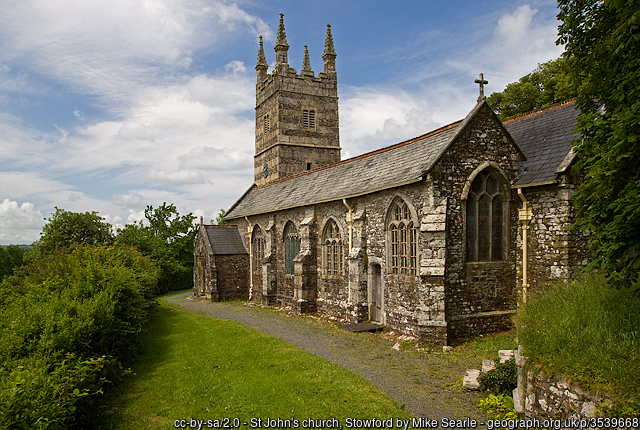
Stowford Church
Photograph © Mike Searle
This one is slightly shorter - only five miles. A bit better going, but there is still some muddy bits. Once again gradual rolling hills, but only one steep descent bit when coming out of Stowford.
There will probably be time to stop in Stowford. The Church itself is medieval and a Grade 1 listed building, but there is certainly evidence of a much earlier one, probably an early Christian graveyard anyway. There is a Saxon memorial stone dedicated to one named probably "Gunglei". He must have been an important person to have such a memorial.

Lifton
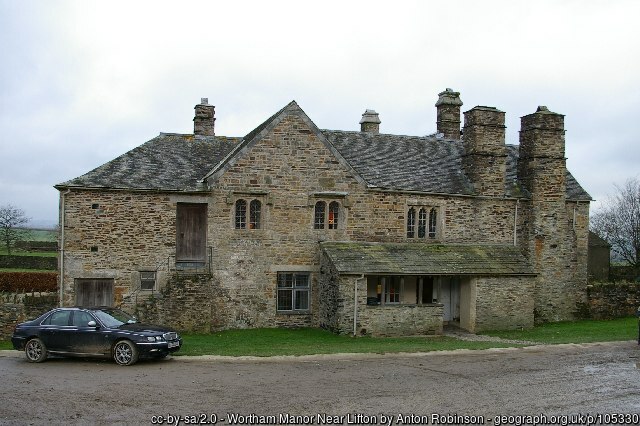
Wortham Manor, Lifton
Photograph © Anton Robinson
Very important to King Alfred the Great. The village was in a strategic posiition because it was on a major route to Cornwall and therefore useful for Saxon armies.
The A30 runs nearby and once ran through the village. This has been an important road for centuries.
The current church is Norman, but if this was a settlement in the Saxon period there it is likely there was an earlier one, wooden probably as many of the Saxon ones were.
There are two medieval mansions from Domesday, Ashleigh now just a farmhouse and Wortham which is unchanged more or less.
Wortham Manor belongs to The Landmark Trust which restores historic buildings and then let them for holidays.

Stage Four - the final stage
Lifton to Launceston
The final five miles is mostly on road. There are some gradual rolling hills and the only steep climb is into Launceston and the end of the walk.
Polson Bridge is the main entry to Cornwall. It is documented in Norman times. It is of course possible there was a crossing for centuries before that, but there does not appear to be any evidence of a crossing here earlier than the 13th century. If there was - one can imagine it must have been well guarded in troubled Saxon times! The Normans thought it important! With Launceston Castle not far away it does suggest there may have been an earlier crossing in the area. The Normans did take over the old useful Saxon and Celtic strategic positions.
The trail drops into the River Kensey valley then climbs steeply into Launceston and the Castle.

Launceston
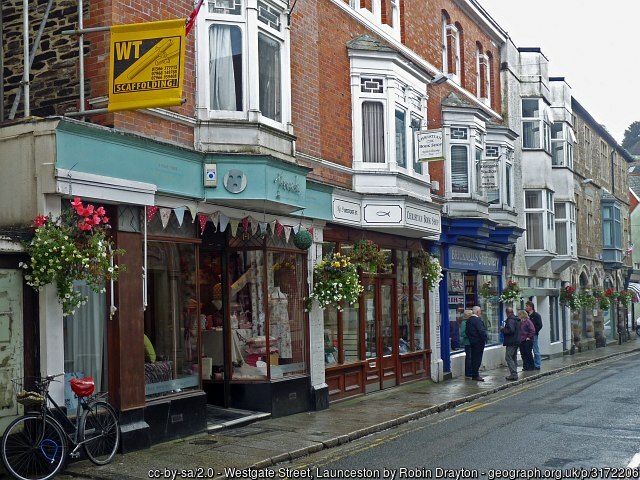
Westgate Street, Launceston
Photograph © Robin Drayton
This lovely ancient market town was the first capital of Cornwall. It was known as Dunheved in Saxon times. Known today as the Gateway to Cornwall.
It is the site of the earliest Saxon Mint in Cornwall.
Situated just a mile from the Cornish border the Normans built that prominent castle. Quite strategic with the river crossing so close. It was the half brother of William the Conqueror who built the castle.
Explore those narrow streets and find shops of all kinds, from local produce to some very unique products. It is a lovely place set as it is among glorious Cornish countryside, well worth a visit for the town itself let alone as the jumping off point for Cornwall and all its beauties.

Two Castles Way connects with West Devon Way, Dartmoor Way. Tamar Discovery Trail, The Tarka Trail and the Devon Heartland Way

Guide to Two Castles Way
Devon County Council publishes an excellent Guide to Two Castles Way as a PDF. It outlines the route in considerable detail and gives side trips, an alternative route on part of the trail and other bits of information, Well worth downloading and taking with you.

Other pages that my be of interest

Return from Two Castles Way to Home
Or you may prefer to browse some more, please do, you will find navigation buttons above on the left.

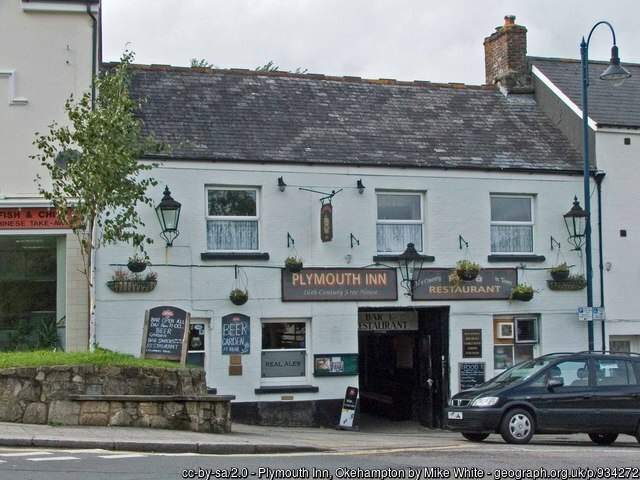
Plymouth Inn, Okehampton
Photograph © Mike White

Useful Information
Things change. Always check out the external links for the latest information.
These are just helpful suggestions only.
There is only one affiliate link, SBI.
Travel Wessex is a Guide.


This is a developing map. Some areas have better coverage.
To find the nearest Electric Vehicle Charging Point please click here.

Public Transport
If you do decide the leave the car at home and help the environment too, why not go National Express. They run coaches all over the country. Some pretty good fares too.
Just imagine - sit back and relax, no hassling with the traffic!!!
Do you know that you can book on your mobile phone and they will send the ticket as a text!!!!

National Rail Journey Planner.
For train journeys all over the United Kingdom connecting the places you want to go efficiently and quickly.

Traveline is a very useful resource for public transport throughout Wessex, even local buses. In fact all over the United Kingdom.



